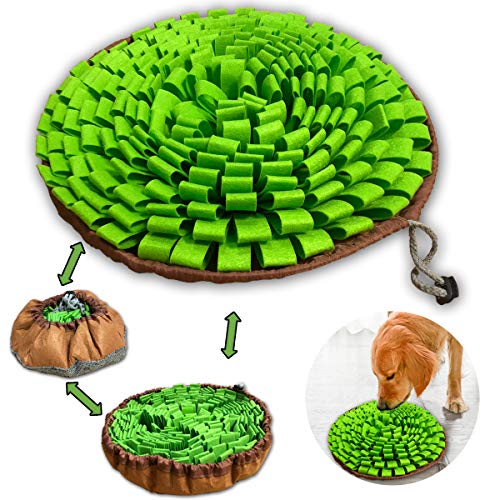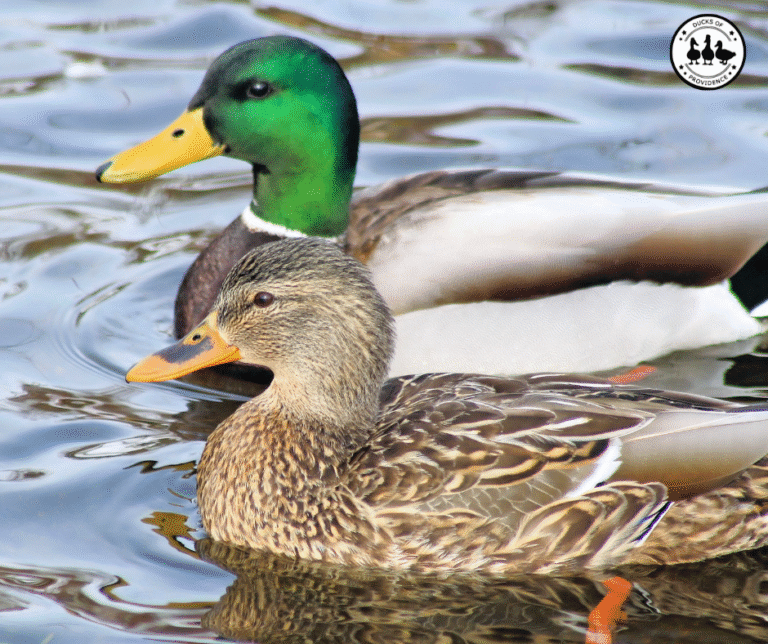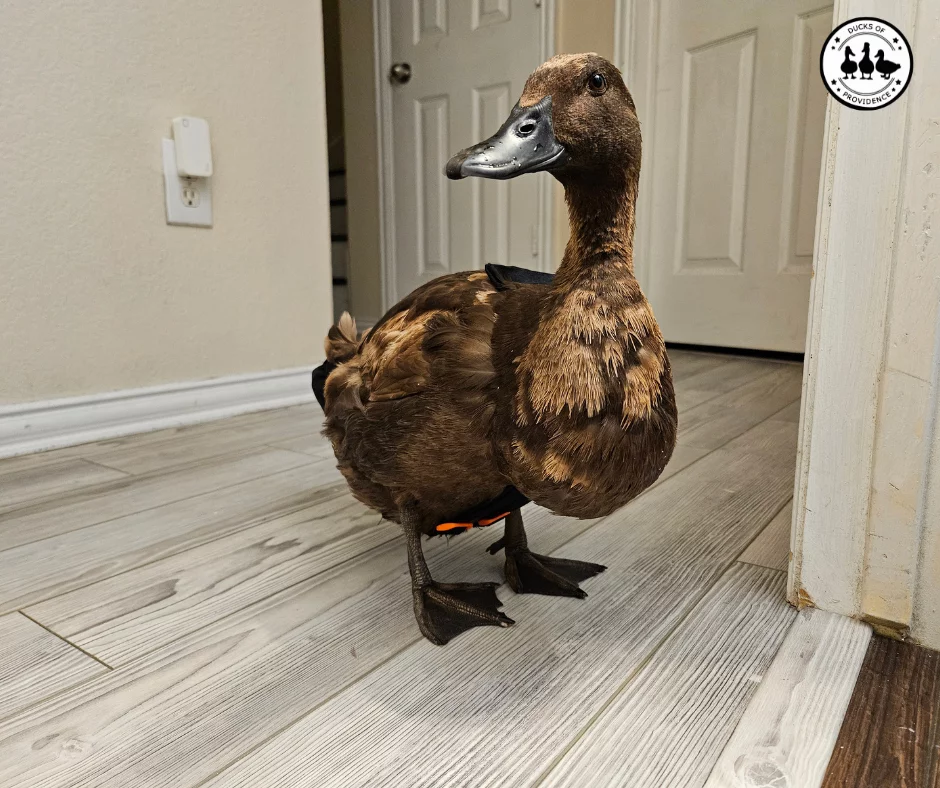
Can You Keep Ducks Indoors as a House Pet?
Last updated on October 6th, 2024 at 01:41 pm
The popularity of ducks as house pets has surged in recent years, fueled in part by viral sensations like Wrinkle the Duck. These social media stars have brought attention to the idea of keeping ducks indoors, sparking curiosity among pet enthusiasts. However, while the notion of having a duck as a house companion may seem appealing, there are important considerations to bear in mind. In this article, we’ll explore the practicalities, benefits, and challenges of indoor duck keeping. Whether you’re drawn to the idea by viral videos or intrigued by unconventional pet ownership, let’s examine what it really takes to care for ducks indoors.
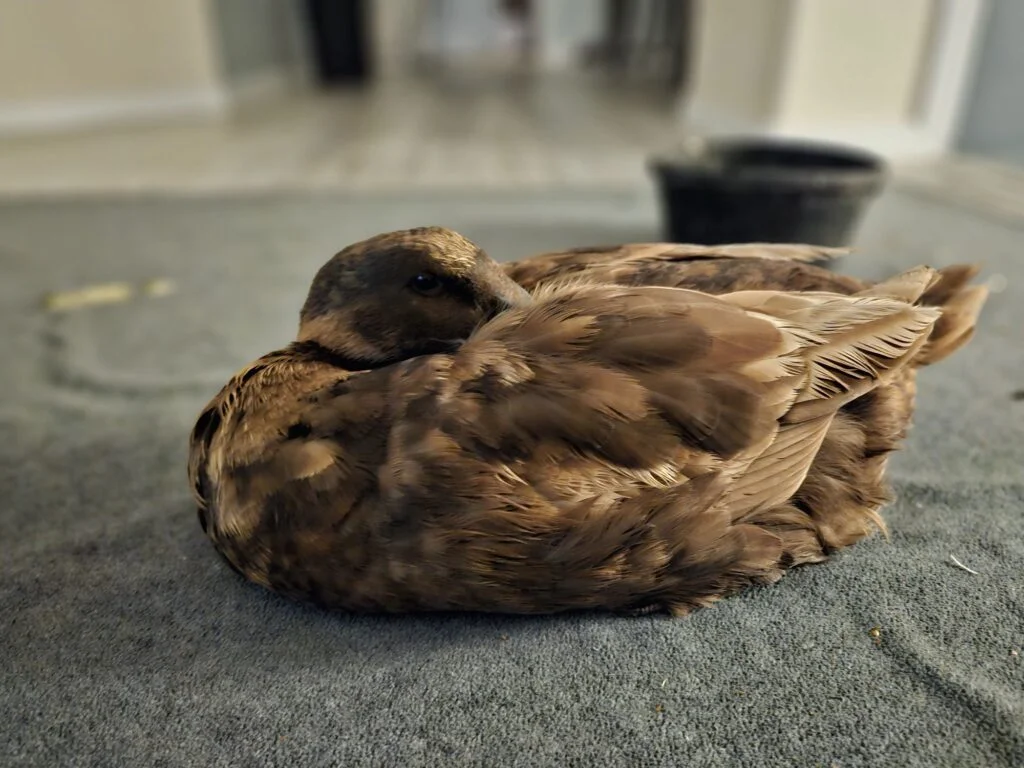
Disclaimer: I may earn a commission if you buy products or services through my affiliate links. This will not affect the price you pay. I only recommend products or services that I believe will be beneficial to my readers.
Advantages of Indoor Duck Keeping:
While the traditional image of ducks may involve paddling in ponds or foraging in open spaces, there are several advantages to keeping them indoors as house pets.
- Protection and Safety: One of the primary benefits of indoor duckkeeping is its enhanced protection and safety for your feathered friends. Indoors, ducks are shielded from potential predators such as foxes, raccoons, or birds of prey, reducing the risk of harm or predation.
- Weather Protection: Indoor living provides ducks with shelter from adverse weather conditions such as extreme heat, cold, or inclement weather. This ensures their comfort and well-being year-round without exposure to harsh elements.
- Constant Supervision and Care: Keeping ducks indoors allows for constant supervision and care, enabling you to monitor their health, behavior, and well-being more closely. This hands-on approach can help detect any issues early and provide timely intervention if needed. It’s particularly beneficial for raising ducklings, as they require attentive care and monitoring during their early stages of development.
- Closer Interaction and Bonding: Indoor duck keeping fosters closer interaction and bonding between ducks and their human caregivers. Ducks raised indoors often become more accustomed to human presence, leading to stronger bonds and more interactive relationships.
- Convenience: Indoor duck keeping offers convenience, particularly for those living in urban or suburban areas with limited outdoor space. It eliminates the need for large outdoor enclosures or ponds, making duck ownership more feasible for a wider range of households.
By bringing ducks indoors, you not only provide them with a safer and more controlled environment but also enhance the quality of their interaction with you, their caregiver. However, it’s essential to consider several factors before making the decision to keep ducks indoors. Let’s explore these considerations in the next section.
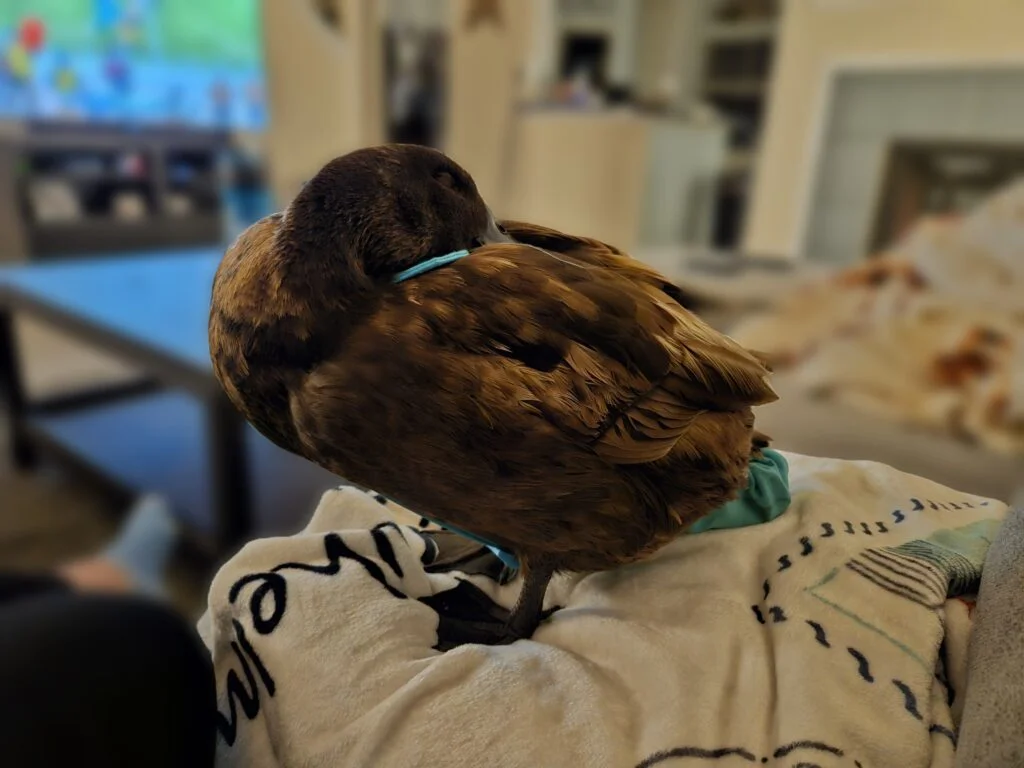
Disadvantages of Indoor Duck Keeping:
While indoor duck keeping offers numerous benefits, it’s essential to consider the potential drawbacks before making the decision to bring ducks indoors. Here are some disadvantages to keep in mind:
- Space Limitations: Indoor living spaces may not always provide enough room for ducks to engage in natural behaviors such as swimming, foraging, and socializing. Ducks require ample space to move around and exercise, and indoor environments may not always offer sufficient space for these activities.
- Mess and Odor: Ducks can be messy animals, and indoor duck keeping may result in increased cleanup duties. Ducks produce waste frequently, and indoor living spaces may require more frequent cleaning to maintain cleanliness and prevent odors. Additionally, ducks may track mud and water throughout the house, adding to the cleanup responsibilities.
- Noise: Ducks are not known for being quiet pets. Their quacking and splashing can be noisy, especially in smaller living spaces. If you have close neighbors or live in an apartment, noise from indoor ducks may be a concern.
- Health Risks: Indoor environments may pose health risks to both ducks and humans if proper hygiene practices are not followed. Ducks may be exposed to indoor pollutants, allergens, and respiratory irritants, increasing the risk of respiratory issues and other health problems. Additionally, ducks kept indoors may be more prone to vitamin D deficiency due to limited exposure to natural sunlight.
- Socialization Needs: Ducks are social animals that thrive on companionship and interaction. While indoor duck keeping can provide opportunities for bonding with human caregivers, ducks may miss out on social interactions with other ducks or compatible pets. Lack of socialization may lead to loneliness and boredom in indoor ducks.
- Limited Outdoor Access: Indoor ducks may have limited access to outdoor environments, depriving them of opportunities for natural behaviors such as foraging, exploring, and basking in natural sunlight. While supervised outdoor time can help address this limitation, it may not fully replace the benefits of free-ranging outdoor living.
By considering these disadvantages alongside the benefits of indoor duck keeping, you can make an informed decision about whether indoor duck keeping is suitable for you and your living situation. While indoor duck keeping may not be ideal for everyone, it can be a rewarding and fulfilling experience for those willing to overcome its challenges.

Considerations Before Bringing Ducks Indoors:
Before deciding to bring ducks indoors as house pets, it’s crucial to consider several factors to ensure their well-being and your ability to meet their needs adequately.
- Space Requirements: Ducks require ample space to move around, stretch their wings, and engage in natural behaviors. When keeping ducks indoors, providing enough room for them to walk, flap their wings, and explore comfortably is essential. Consider the size and layout of your living space to determine if it can accommodate the needs of indoor ducks.
- Environmental Enrichment: Ducks thrive on stimulation and enrichment, even when living indoors. It’s essential to create an environment that mimics their natural habitat as much as possible. This includes providing access to shallow containers or bowls, a bathtub for swimming and bathing, and suitable bedding and nesting areas for resting and nesting behavior.
- Hygiene and Cleanliness: Indoor duckkeeping requires diligent maintenance to ensure a clean and hygienic environment for ducks and humans. Ducks produce waste frequently, so regular cleaning of their living area is necessary to prevent odor buildup and maintain hygiene. Choose easy-to-clean and disinfect flooring materials, such as linoleum or tile, to facilitate cleaning routines. Additionally, consider using duck diapers to minimize mess and facilitate indoor living.
- Ventilation and Air Quality: Adequate ventilation is essential for indoor duck habitats to prevent the buildup of moisture and ammonia from waste. Ensure proper airflow in the duck’s living space to maintain optimal air quality and prevent respiratory issues. Consider using fans or opening windows periodically to promote ventilation, especially in enclosed spaces.
- Behavioral Considerations: Ducks are social animals that thrive on companionship and interaction. If keeping ducks indoors, consider their social needs and provide socialization and mental stimulation opportunities. Interaction with humans and, if possible, other ducks or compatible pets can help prevent boredom and loneliness. Remember, ducks should never be kept alone, and having at least two is recommended to provide companionship and prevent loneliness.
- Outdoor Activities: Ducks benefit from regular outdoor activities to fulfill their natural instincts and maintain physical health. Provide opportunities for supervised outdoor time in a safe and secure outdoor area, allowing ducks to forage, explore, and bask in natural sunlight.
- Landlord or City Ordinances: Landlords or city ordinances may restrict or prohibit the keeping of ducks indoors, especially in rental properties or urban areas. Before bringing ducks indoors, it’s essential to check with your landlord or local authorities to ensure compliance with any regulations or restrictions regarding pet ownership.
By carefully considering these factors and assessing your ability to meet the needs of indoor ducks, you can make an informed decision about whether indoor duck keeping is suitable for you and your living situation. In the next section, we’ll explore how to set up a duck-friendly indoor environment to ensure your ducks’ comfort and well-being.
Setting Up a Duck-Friendly Indoor Environment:
Creating a duck-friendly indoor environment is essential for ensuring the comfort, health, and well-being of your feathered companions. Here are some practical tips for setting up a suitable living space for indoor ducks:
- Choose the Right Flooring: Select flooring materials that are easy to clean and maintain. Options such as linoleum, tile, or waterproof laminate are ideal for indoor duck habitats, as they can withstand frequent cleaning and are resistant to water damage.
- Protective Barriers: Consider using blankets or puppy pads to protect your furniture and flooring indoors. Cover furniture with waterproof pet blankets where ducks rest or nest to shield against dirt and moisture. Place disposable or washable puppy pads in high-traffic areas to absorb moisture and simplify cleanup. These measures help create a duck-friendly indoor space while safeguarding your home’s surfaces.
- Provide Ample Space: Ducks require plenty of room to move around and engage in natural behaviors. Ensure that their indoor living space is spacious enough to accommodate their needs, allowing them to walk, flap their wings, and explore without feeling cramped.
- Create a Duck-Friendly Living Area: Set up a designated living area for your ducks that includes essentials such as bedding, nesting boxes, and shallow containers for drinking and preening. Arrange these items to mimic their natural habitat, providing opportunities for rest, relaxation, and activity. We have a pet playpen for our part-time house duck, Krümel, as her ‘bedroom.’
- Ensure Proper Ventilation: Proper airflow is essential for maintaining good air quality and preventing the buildup of moisture and odors. Install vents or fans to promote ventilation in the duck’s living space, and open windows periodically to allow fresh air to circulate.
- Monitor Temperature and Humidity: Ducks are sensitive to temperature extremes and humidity levels. Keep their indoor environment within a comfortable range, avoiding excessively hot or cold conditions. A thermometer and hygrometer are used to monitor temperature and humidity levels regularly.
- Provide Access to Water: Ducks require access to clean water for drinking, bathing, and preening. Provide shallow water dishes or containers for drinking, as well as larger containers or kiddie pools for swimming and bathing. Ensure that water is changed regularly to maintain cleanliness.
- Offer Environmental Enrichment: Ducks thrive on stimulation and enrichment, even when living indoors. Provide toys, puzzles, and interactive games to keep your ducks mentally engaged and entertained. Rotate toys regularly to prevent boredom.
- Natural Lighting: Whenever possible, place your duck’s living area near a window to provide natural light. Natural sunlight is beneficial for ducks’ health and well-being, and exposure to daylight helps regulate their biological rhythms.
- Duck-Proof Your House: Ducks are curious and can be mischievous, so it’s essential to duck-proof your home to prevent accidents and damage. Remove or secure any hazardous items, such as electrical cords, toxic plants, or small objects that could be ingested. Consider installing baby gates or barriers to limit access to certain areas of your home.
By following these guidelines and creating a duck-friendly indoor environment, you can ensure that your ducks thrive and lead fulfilling lives as indoor house pets. In the next section, we’ll discuss meeting the dietary needs of indoor ducks to ensure they receive a balanced and nutritious diet.

Meeting Dietary Needs:
Providing a balanced and nutritious diet is essential for the health and well-being of indoor ducks. Here are some guidelines for meeting their dietary needs:
- Commercial Duck Feed: Start by offering a high-quality commercial duck feed formulated specifically for ducks. Duck feed typically contains the essential nutrients, vitamins, and minerals that ducks need to thrive. Choose a feed that is appropriate for your duck’s age and life stage, whether they are ducklings, adults, or layers.
- Fresh Vegetables and Greens: Supplement your duck’s diet with fresh vegetables and greens to provide additional vitamins, minerals, and dietary fiber. Offer a variety of vegetables such as leafy greens, carrots, peas, and corn. Avoid feeding onions, garlic, and avocado, as these can be toxic to ducks.
- Occasional Treats: Ducks enjoy occasional treats, such as fruits, mealworms, or grubs, as part of a balanced diet. Offer treats in moderation to prevent overfeeding and ensure that they remain a small portion of your duck’s overall diet.
- Clean Water: Ensure that your ducks have access to clean, fresh water at all times for drinking and bathing. Ducks need water for hydration, digestion, and maintaining healthy plumage. Change water frequently to prevent contamination and ensure cleanliness.
- Monitor Food Consumption: Monitor your duck’s food consumption and adjust portions to prevent obesity or undernourishment. Ducks have different nutritional requirements depending on their age, breed, and activity level, so it’s essential to tailor their diet accordingly.
- Calcium Supplementation: If you have laying ducks, consider providing calcium supplementation, such as crushed oyster shells or commercial calcium supplements, to support eggshell production and prevent calcium deficiencies.
- Consult a Veterinarian: Consult with a veterinarian experienced in avian care to ensure that your ducks receive a balanced and appropriate diet for their specific needs. A veterinarian can provide personalized recommendations based on your duck’s health status and dietary requirements.
By providing a balanced diet consisting of commercial duck feed, fresh vegetables, occasional treats, and clean water, you can ensure that your indoor ducks receive the nutrition they need to thrive. In the next section, we’ll discuss health and wellness considerations for indoor ducks, including preventive care and common health issues to watch out for.
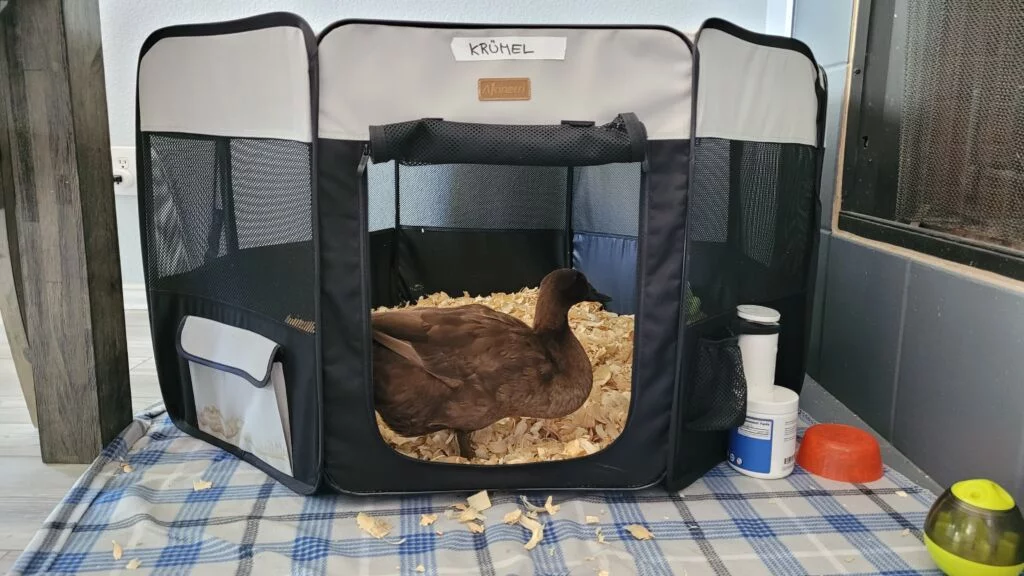
Health and Wellness Considerations:
Ensuring the health and wellness of indoor ducks is essential for their overall well-being and longevity. Here are some key considerations to keep in mind:
- Regular Veterinary Check-ups: Schedule regular veterinary check-ups for indoor ducks to monitor their health and detect potential issues early. A qualified avian veterinarian can conduct thorough examinations and provide guidance on nutrition, housing, and other aspects of duck care. You can find avian vets in this database from Poultry DVM.
- Disease Prevention: Practice good biosecurity measures to minimize the risk of disease transmission to your ducks. This includes limiting contact with wild birds, disinfecting equipment and living areas regularly, and preventing access to contaminated water sources.
- Educate Yourself: Be aware of common duck health issues to ensure prompt identification and treatment. Watch for signs of respiratory issues, such as coughing or sneezing, which could indicate infections or environmental irritants. Monitor for lameness or difficulty walking, which may signal joint problems or injuries. Keep an eye out for changes in appetite, behavior, or fecal consistency, as these can indicate digestive issues or internal parasites. By staying vigilant and recognizing these common health issues early, you can help keep your ducks healthy and thriving.
- Exercise and Mental Stimulation: Ducks benefit from regular exercise and mental stimulation to maintain their physical and mental health. Provide opportunities for supervised outdoor activities in a safe and secure environment, allowing your ducks to forage, explore, and engage in natural behaviors.
- Obesity Prevention: Monitor your ducks’ body condition and weight regularly to prevent obesity, which can lead to various health issues, including joint problems and heart disease. Ensure that your ducks receive appropriate exercise and a balanced diet to maintain a healthy weight.
- Respiratory Health: Ducks are susceptible to respiratory infections, especially in poorly ventilated environments. Maintain proper ventilation in your duck’s living area, and promptly address any signs of respiratory illness, such as coughing, sneezing, or nasal discharge, by consulting with your veterinarian.

Pet Duck Guide
This is the BEST book about ducks I have ever had. I can highly recommend it to every duck owner, new or experienced. It is very comprehensive, with pictures and illustrations. It covers all topics related to duck care and keeping ducks. It even has multiple case studies.
By prioritizing preventive care, monitoring your ducks’ health closely, and seeking veterinary attention when needed, you can help ensure that your indoor ducks enjoy optimal health and well-being. In the next section, we’ll discuss the importance of regular exercise and mental stimulation for indoor ducks, as well as tips for providing enrichment activities to keep them happy and engaged.
Exercise and Mental Stimulation:
Just like their outdoor counterparts, indoor ducks require regular exercise and mental stimulation to stay healthy and happy. Here are some tips for providing enrichment activities for your indoor ducks:
- Outdoor Time: Whenever possible, allow your ducks supervised outdoor time in a safe and secure environment. Create a duck-proofed outdoor area where they can forage, explore, and soak up natural sunlight. Outdoor activities provide valuable opportunities for exercise, mental stimulation, and exposure to fresh air and natural surroundings.
- Indoor Activities: Even when indoors, you can provide enrichment activities to keep your ducks entertained and engaged. Offer toys, snuffle mats, and interactive games to encourage natural behaviors such as foraging and exploring. Rotate toys regularly to prevent boredom and maintain interest.
- Social Interaction: Ducks are social animals that thrive on companionship and interaction. If possible, provide opportunities for your ducks to socialize with other ducks or compatible pets. Social interaction helps prevent loneliness and boredom, promoting your ducks’ overall well-being.
- Training Sessions: Ducks are intelligent animals that can be trained to perform simple behaviors using positive reinforcement techniques. Consider incorporating short training sessions into your daily routine to teach your ducks fun and useful tricks. Training sessions provide mental stimulation and strengthen the bond between you and your ducks.
- Foraging Opportunities: Encourage natural foraging behaviors by hiding treats or food items around your duck’s living area. Scatter food in different locations or hide it inside puzzle toys to encourage your ducks to search and explore. Foraging activities provide mental stimulation and mimic the natural behavior of ducks in the wild.
- Variety in Environment: Ducks enjoy exploring new environments and experiencing different sensory stimuli. Provide variety in your duck’s living environment by rearranging furniture, adding new toys or objects, or introducing changes in lighting and sound. Novelty stimulates your duck’s curiosity and keeps them mentally engaged.
By incorporating these enrichment activities into your indoor duck’s daily routine, you can help promote their physical and mental well-being while providing opportunities for natural behaviors and social interaction. In the next section, we’ll conclude our discussion by summarizing the key points and encouraging readers to embark on their own quacking adventure with indoor duck keeping.
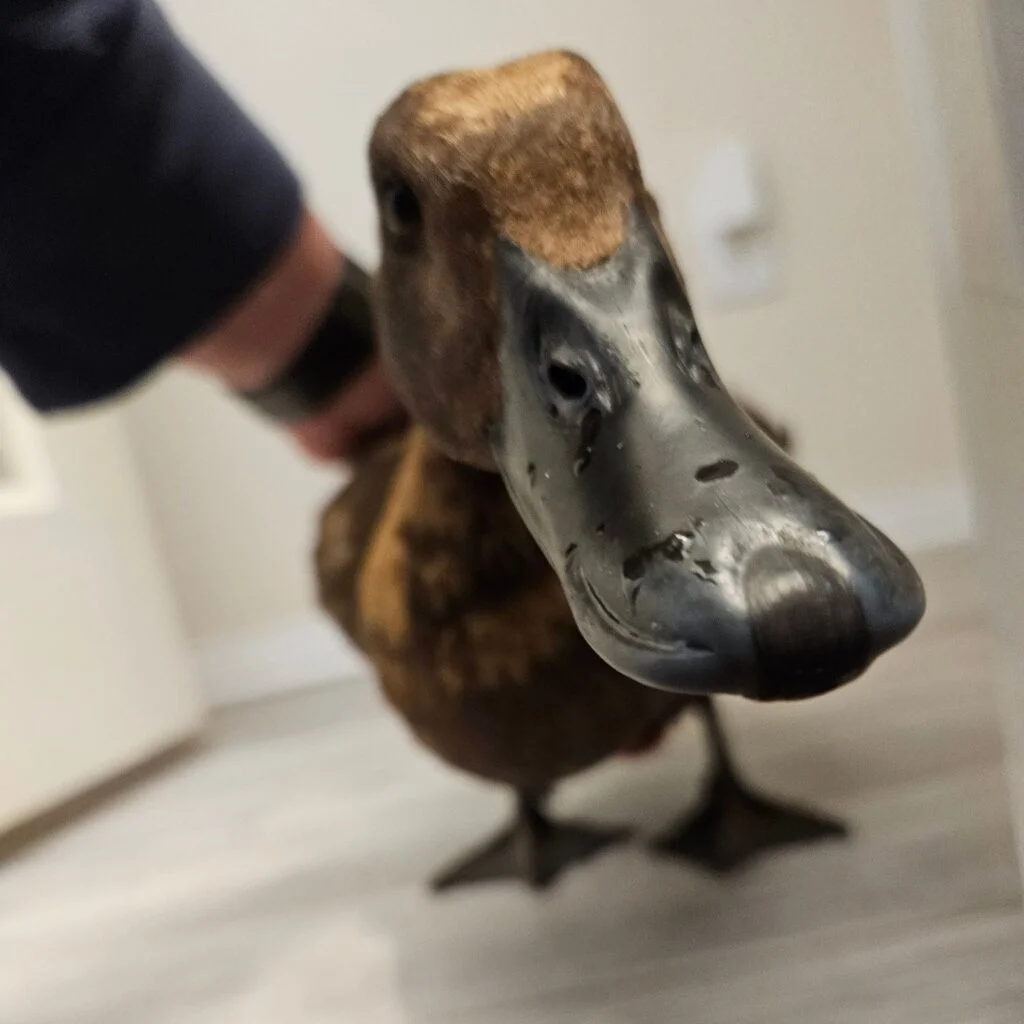
Wrapping Up: Is Indoor Duck Keeping Right for You?
In this article, we’ve explored the possibility of keeping ducks indoors as house pets, delving into the practicalities, benefits, and considerations of indoor duck keeping. From providing a safe and enriching environment to meeting dietary needs and promoting health and wellness, indoor duck keeping offers a unique and rewarding experience for both ducks and their human caregivers.
By carefully considering factors such as space requirements, environmental enrichment, and socialization needs, you can create a duck-friendly indoor environment that meets the needs of your feathered companions while enhancing your bond with them. From setting up a designated living area to providing opportunities for outdoor activities and mental stimulation, indoor duck keeping allows you to bring the joys of duck ownership into your home.
Since we have a part-time house duck ourselves, we have tested many products and have found some that work very well. We have assembled them in our Amazon Shopping list below. We invite you to check it out if you have or are planning to have house ducks.

Whether you’re drawn to the idea by viral duck videos, intrigued by unconventional pet companionship, or simply looking for a new and rewarding experience, indoor duck keeping offers a quacky adventure like no other. With dedication, care, and a little quirkiness, you can embark on a journey filled with joy, laughter, and endless quacks with your indoor duck companions.
So why not take the plunge and welcome ducks into your home? With “Can You Keep Ducks Indoors as a House Pet?” as your guide, you’re ready to embrace the wonders of indoor duck keeping and join the growing community of duck enthusiasts around the world. Here’s to many quacky adventures ahead!
Related Posts You May Enjoy:
- Pet Ducks: The Ultimate Guide to Keeping and Caring for Them
- Duck Diapers Demystified: Answering Your Top 9 Questions
- 7 Must-Have Pet Duck Accessories
- Keeping Ducks 101: A Beginner’s Guide to Duck Care
- What do Pet Ducks Eat? A Guide to a Healthy and Nutritious Pet Duck Diet
- 15 Common Duck Health Conditions You Should Know About
- Ducks and Water: Keeping Your Flock Happy and Healthy




